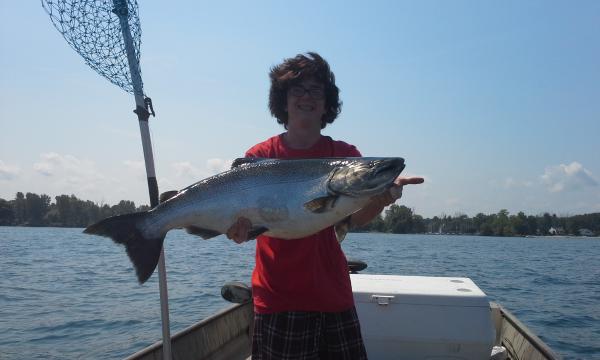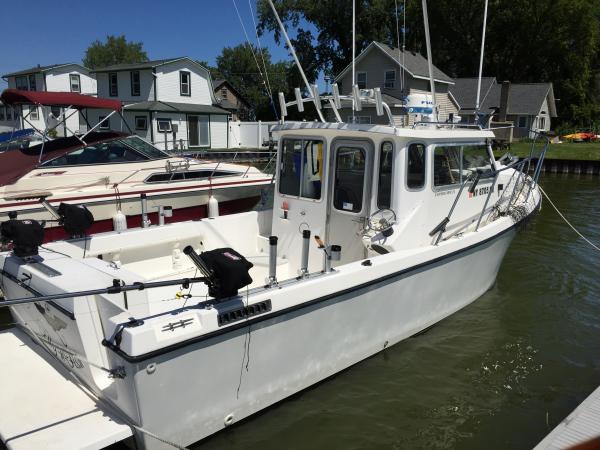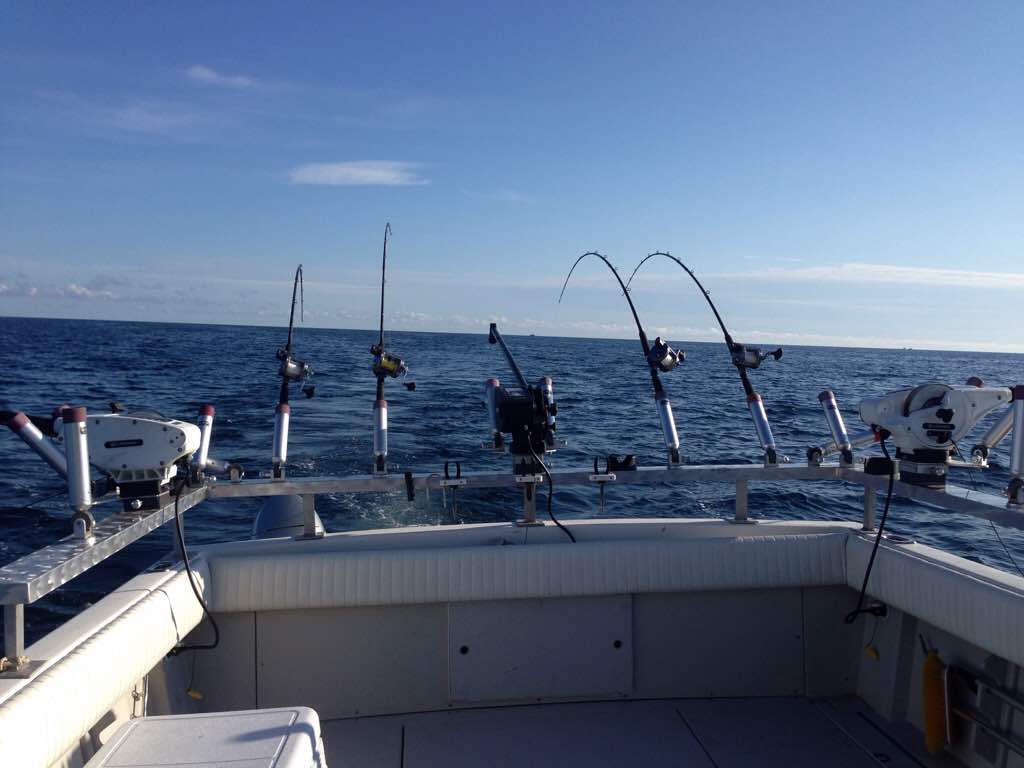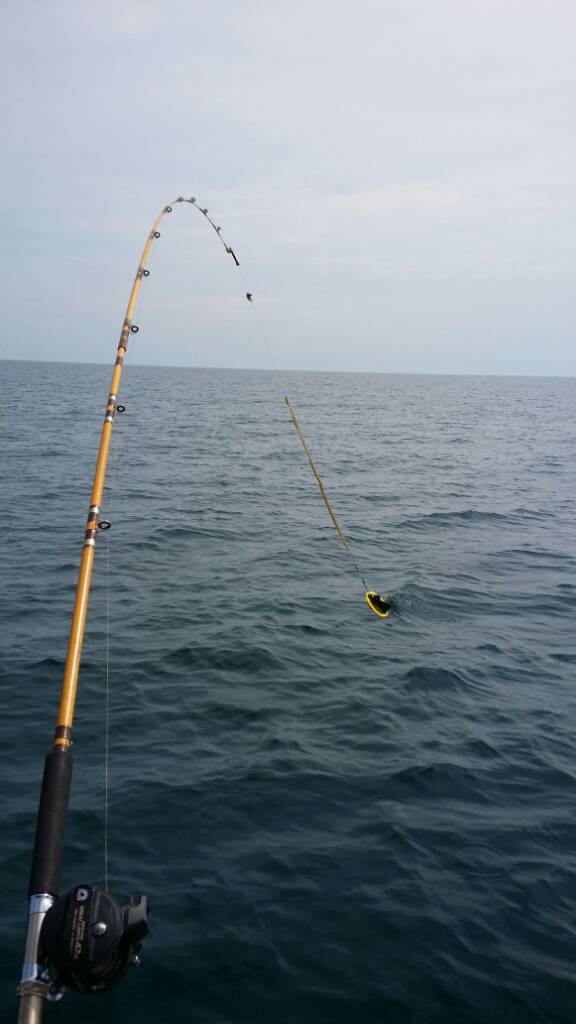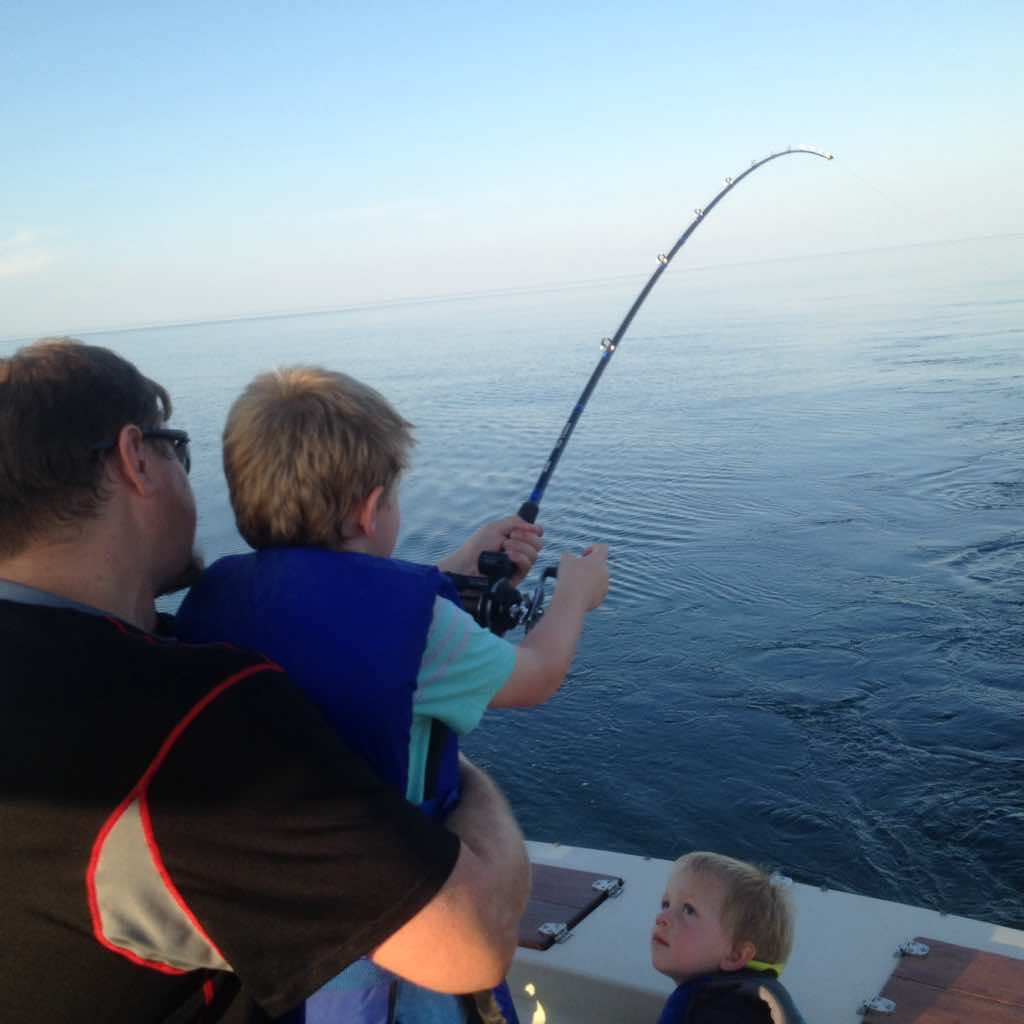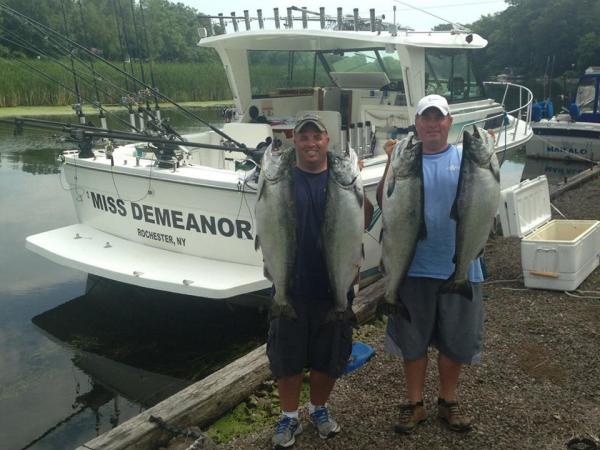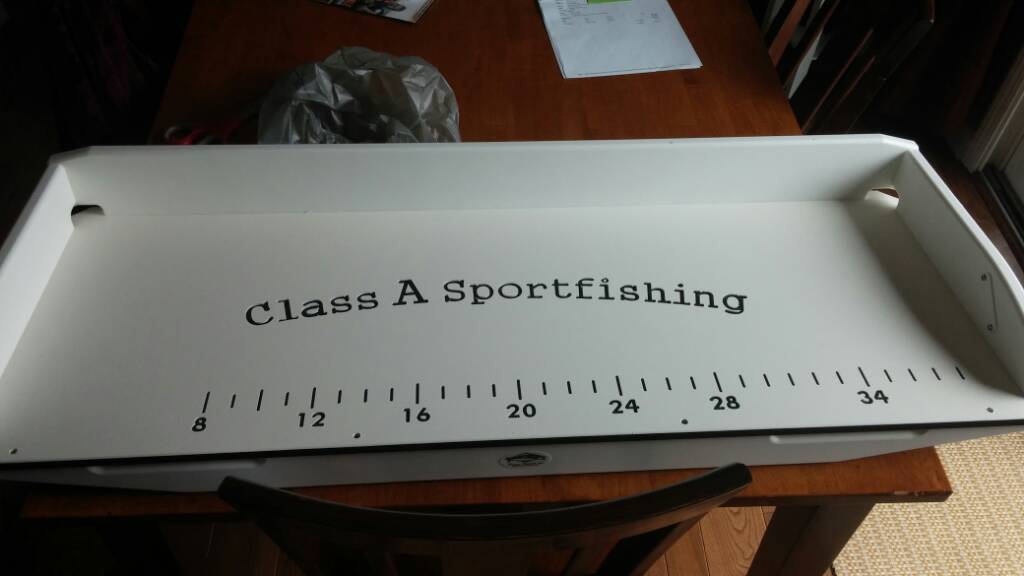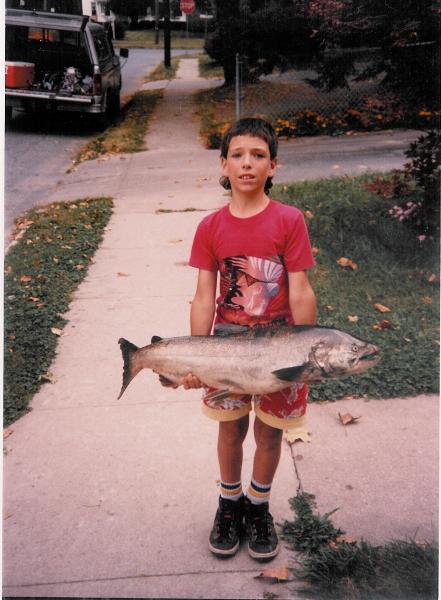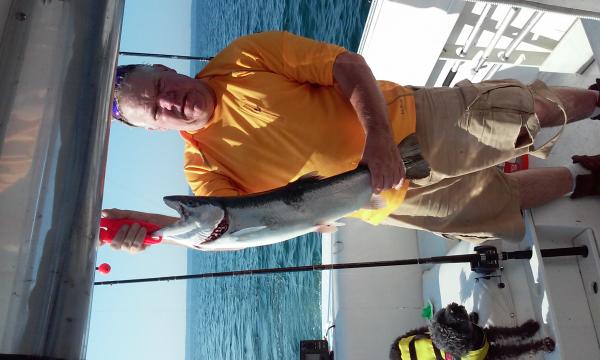-
Posts
441 -
Joined
-
Last visited
Content Type
Profiles
Forums
Events
Gallery
Store
Everything posted by pvelyk
-
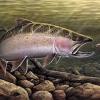
Sandy /Hamlin 8/15-8/16
pvelyk replied to wishinfishin's topic in New York Fishing Reports - Lake Ontario (South Shore)
Congrats, you did a great job under tough conditions both with the boat and the fishing. It's nice reminding the kids there is life besides electronics and not everything goes your way but if you try hard enough it eventually pays off. That is being a great dad. I hope you have many more days on Lake O that are more fruitful but just as rewarding as Sunday. -

Sandy Creek - 8-16-15
pvelyk posted a topic in New York Fishing Reports - Lake Ontario (South Shore)
Family, and who's kidding, I got moving slow today. Hit the water around 10:15 and put down in 100 fow in front of the pump house. The fleet was mostly out east of us and slightly deeper. We started trolling north and was pretty unhappy with the picture we saw. Between 100-450 marked 3 small schools of bait and two streakers and that was it. Deep rigger was 110 down over 450 and in 44 degrees of water when we got our first hit. The fish took a proll troll green and silver 11" eclip flasher with a dream weaver cut bait rig and never stopped. Looks like the knot failed and we lost the rig and fish. Reset up with my only other flasher, a 8" glow on white flasher and John king meat head. Hit 515 feet of water and that fired off and we brought in a small 10 pound king in. Pretty much all the action on rods and fish finder for the day. Picked up around 3:30 after hitting 530 of water and trolling back in to 420 feet. -

I-Bay 8/15 with new boat to me
pvelyk replied to Fly n Fish's topic in New York Fishing Reports - Lake Ontario (South Shore)
-
Welcome to the board Ralph. There are a lot of great fisherman here that will give you great advice and each will give you a piece of the puzzle. But you will hear this one piece of advice over and over, the absolute quickest way to get better fast is to do a charter with one of the charter guys near you. Explain you don't want the charter to go out and catch fish but to learn and they will be happy to explain the process to you and help you start boating fish yourself. Besides that read the posts here, there are years of them to back to, ask questions, go to seminars and talk to the guys at the docks. Pay attention to details as small one can make the difference between crazy days or a skunk and constantly try things. Make one change at a time so when success occurs you know what to repeat. Good luck and enjoy netting that first one.
-
Any size to them? On a slow day I would take that.
-

Hi, we are Ed and Jeff, Bucks Boat out of Sandy creek
pvelyk replied to eam's topic in Introduce Yourself
PM sent -
Wait, does this mean I can't trust you to rig dipseys?
-
I was on Kickstarter this morning looking around and saw this campaign: https://www.kickstarter.com/projects/gofishcam/gofish-cam?ref=category . Price seems good (As cheaps as $115) but based on my campaign supporting track record, Kickstarter projects coming to completion is about 50-50. I am in no way involved in this project or recommending it just making people aware of it as I know there have been conversations of getting cameras off downriggers to catch the action down there. Equipped with HD 1080p color video and infrared lights for night vision, the GoFish Cam catches the complete underwater experience through a 170° wide-angle lens and built-in microphone even in the darkest of conditions. It’s fishing like you’ve never seen before – trust us!
-
I was used to driving an 18 foot open bow on Conesus Lake and when I bought a bigger boat with a closed bow this year for the lake the biggest issue I had and still sometime have is docking. The first two times were a three ring circus, now for the most part I do all right but every so often I get a day that reminds me I need more practice. Channel and Lake control are non issues. Best advice is patience and be calm, which of course is easier said than done in the beginning.
-

FLEAS
pvelyk replied to battlehammer's topic in New York Fishing Reports - Lake Ontario (South Shore)
-

Boat stalls at low speed / idle after time on lake?
pvelyk replied to DreadPirateRoberts's topic in This Old Boat
Had similar problem earlier this year with new to me boat. It started up fine but would stall at very low speeds, most often on the way in and trying to dock. As Missdemeanor says the cap and the rotor a great place to start and for me was the issue. He helped me change it and we could see a large amount of corrosion. Boat has run great since then. -
Don't get too hung up on the exactness of he numbers too, the counter on your rigger will rarely if ever be exactly the depth you are. Cable blow back from trolling speed and currents alone guarantee that, amongst other things. These numbers get you in the right area of water and in most cases fish will move vertically to the lure a bit, the amount they will move will be based on there aggressiveness.
-

Bear Creek 7/27 evening
pvelyk replied to Wolfhound's topic in New York Fishing Reports - Lake Ontario (South Shore)
-
Fished from about 2 to 7:30 today. We started shallow looking for browns or Lake trout on the bottom, not much in way of marks until we saw some bottom huggers around 90 feet but nothing wanted to play. We had our first release 75 over 125 on a rigger with a black and green stinger. Unfortunately we lost the fish after it started to run accross the copper we were running down the shoot. Sometimes the bonus rods produce and sometime they cost you a fish. We continued to work 100 to 225 for the next two hours without much happening, so we started working out deeper. We got another decent fish on 70 foot down over 235 on a stinger green alewive spoon but it only was on for a short run and then came unleashed. We worked our way out to four hundred feet with nothing happening so we decided to pull the lines in an run back in and work the 100 to 200 feet water again. Puling up the rods we found a 3 lb steelie skipper. We wroked inside the rest of the night goig as shallow as 75 feet and deep as 200 with the water column from 45-110 covered with our lines. Again we marked bottom huggers and some streakers with no knock offs. We pulled gear and again found another steelie free loading a ride on a deep rigger. He made the other one look giant and had big eyes and attitude going for a lure about his own size.
-
Thanks Tom, Edits made and new additions added.
-
If someone gives me a good definition for the two speeds that we all agree on the wording I am happy to change. Again I would love for this to be a community driven glossary that we do once and is easily located for anyone looking for a definition. Sent from my iPhone using Lake Ontario United
-
Lily, what you are referring to only applies to Atlantic salmon and Lake trout, otherwise you can process them on the water. Here is the excert from the DEC regulations website: Regulations for Harvested Fish Fish Cleaning Law It is illegal on New York State waters to possess walleye, black bass, brook trout, lake trout or Atlantic salmon that have been cut, dismembered, filleted, skinned or otherwise altered so that the species and total length of such fish cannot be easily determined. However, these fish may be gilled or gutted. Other species of fish may be filleted provided that the skin is not removed from the fillets. This regulation allows more effective enforcement of harvest regulations on protected game fish.
-
This is just and idea at this point and by no means do I believe at this point it to be a definitive glossary. I am hoping others will like this idea and it could get pinned here or in in the reports forums as this is where most people see the terms and wonder what they mean. I also hope this would be a community effort and that by putting a definitions up once we stop the need for it to have to be asked and answered every few months. Not that walleye discussion here is not valid but I was leaning towards the lake side of salmon and trout fishing side for definitions Bottom bouncing also has it's own definition for stream fishing and I am not sure if species or location specific terms may best be put into the forum that is the best fit for them. Again I am open to others input to make this useful and better for all who are on the site and leave it up to all to decide what they are willing and want to add, correct or want removed for this list.. I added the flasher and fly definitions.
-
Do you guys think there would be any merit to us creating a pinned Glossary of terms to cut down on what some people see as repeated beginner questions that frustrate a lot of people seeing asked. I started a list and think it could be similar to this and we all could add to it. I am sure a lot of people would get a lot out of it. Especially when they see the terms used in reports. AutoPilot Device that allows the boat to be driven on set course without human interaction. Combined with GPS this device can be used to multiple way points. Backer Fishing line spooled on a reel before the main line. This line is used to make sure the reel is fully filled with line. Reason for using backer is main line being used is cost prohibitive or diameter of main line would not allow enough line on the reel to fight a big fish before being spooled. You see this most often used often with leadcore and copper setups but can be used in many other situation. Blue zone Location on the water "way out there." Generally 400+ FOW. Bottom Bouncing Running your downrigger balls close to the lake floor and occasionally allowing them to very briefly touch bottom. This actions cause a bottom disturbance that often entices lake trout into a bite. Braid Fishing line made up braided man made fabrics that produce a strong line that has a smaller diameter of similar strength mono. Braid line has low stretch and high abrasion risitance. Cheater or Slider Is a setup that is clipped to the main fishing line attached to a downrigger allowing a second lure to be run off one fishing pole. The setup consists of a leader where at one end where a snap swivel connects to a spoon and a snap swivel at the other end connects to the main fishing line of the pole on the downrigger. These can be fixed to a set location using various means or free sliding where theoretically the slid to the outer bow of the fishing line. Chinook Diver See Divers Chute The water directly behind the back of the boat, specifically the area behind the motor. Colors Unit of measure used in Leadcore line. Each color of nylon sheathing on Leadcore is 10 yards. Copper Fishing Line made of copper and used instead of wire, mono, braid or leadcore. Copper is most often used alone as a delivery method and is run flatlined or off of planer boards Cowbells A device used on a fishing rod or downrigger used to attract fish to a lure or bait pulled behind it. This device is usually a leader that has several inline spinner types of attractors. Often used in conjunction with peanuts or spin-n-glos. Most often used for Lake trout fishing. Dipsy Diver See Divers Divers – AKA Dipsy Divers, Deeper Divers, Chinook Divers, ect A device usually in the shape of a round disk that has a small weight attached to about a ¼ of the circumference of the disk. These devices attach to a rod and attain depth by water pressure forcing it down. They also can usually be made to move away from the boat to one side or the other by moving the attached weight to a new position on the device. These devices have a release mechanism in them that when a fish bite it allows the pressure of the water to be removed causing the fish to be the only source of drag during the fight. These are mostly run on wire rods now, but can be run using mono and braid. Dodger An oval piece of metal or plastic used on a fishing line used to attract a fish to the bait run behind it. Often this is a fly or squire bait. Down Speed Speed gathered from a probe connected to a downrigger usually just above the cannonball. This gives the speed at the depth the bait is being fished. This is often different than surface speed due to currents. Down Temp Water temperature from a probe connected to a downrigger usually just above the cannonball. Downrigger A downrigger is a device used while fishing using the trolling method, which places a lure at the desired depth. A downrigger consists of a three to six-foot horizontal pole which supports a cannonball (large weight) by a steel cable (generally stainless steel). A clip, also known as a "release" attaches a fishing line to the cannonball weight. The bait or lure is attached to the release. Fence line The border between the US and Canada Flasher An oval piece of metal or plastic used on a fishing line used to attract a fish to the bait run behind it. It is meant to spin, opossed to a doger that rocks back and forth. Fleas (Spinney Flea or Water Flea) Another Invasive creature that has spread out in the Great Lakes and Finger Lakes. Spiny waterfleas are zooplankton (microscopic animals). Spiny waterfleas eat small animals (zooplankton), including Daphnia, which are an important food for native fishes. In some lakes, they caused the decline or elimination of some species of native zooplankton. They can clog eyelets of fishing rods and prevent fish from being landed. Blooms often occur during the summer are a major reason why small pound test and braid line is not used on rods during these blooms as they will collect on any vertical smaller diameter line and clog eyelets. Fluorocarbon Fishing line that is made of polyvinylidene difluoride and looks somewhat similar to Mono. Its advantages are very low visibility, high abrasion resistance and low stretch. It’s disadvantages is it is much stiffer than monofilament, lower knot strength, especially if correct knots and techniques are not used. Fly (Trolling) Is a lure made of stranded tinsel and threaded with a leader material with hooks attached and has the leader that connected ups to some type of attractor such as a dodger, flasher or spindoctor. FOW Feet of Water. Refers to depth of water. GPS /Chart A device that tells of the boats location based on the use of satellites in space. This information is often present in the context of a map. GPS’s often allow the user to mark a location within 4.5 meters so that you can go back to that location. GPS also give speed of the boat. Inside Location on the water shallower than most boats are fishing. Moves with the season. If most guys are in 150 FOW and you're in 50 FOW then you're fishing the inside water. Junk Lines A Term used to define the running of copper and/or Lead color lines. Kicker A small outboard motor attached to the boat that is only used during trolling. Lamprey Another invasive species. This is a eel that attaches to a fish and with its round mouth bores a hole into the host fish and drains it of its bodily fluid often killing the host. Land speed The speed of the boat measure against movement of the shore. This can be different than down speed or surface due to currents or wind. Leadcore Fishing line made of a strand of copper sheathed in a nylon braid. It is mostly run as its own delivery device and is flat lined or run of planer board. It can be run of riggers. Mature Salmon in 3 or 4 yr class ready to spawn this year. Generally 20+ Lbs Meat Rigs or Bait rig A trolling lure that is setup to accept either whole or partial bait such as alewife, herring, smelt, ect as part of the lure. Monofilament (Mono) Monofilament is a single strand line made of a mixture of plastics. It has high stretch and comes in several shades and colors. Mupped Mupped is when you take a regular and a mag spoon (usually in the same color pattern) and cheat the mag spoon above the regular. Outrigger Poles that extend from the side of the boat. These poles are used to put fishing lines away from the boat similarly to a planer board. Paddles Attractor device used to bring fish close to the bait trailed behind it via a leader. Spin Doctor is an example. Peanuts Slang term used to describe a lure called Wobble Trolls by Yakima Bait company or knock offs of these lures. They are often run behind cowbells. Planer Board A flat board used or small boat like device used in trolling that either attaches to your fishing line and carries the bait out to the side and away from the boat. The board releases when a fish hits so you fight the fish, not the board. Program Trolling plan including lure selection, speed, lake location and depth, bait depth and bait delivery methods such riggers, copper, ect . Release A device that holds fishing line to a downrigger, planner board, outrigger until tripped which allows it to separate and be free of that device. Rocket Launcher A device installed on boats used to store multiple fishing rods over the cabin of the boats. These are often a metal arch that goes from one side of the boat to the other with multiple rod holders. Shaker See Skipper Skipper A small fish. It gets its name from being too small to trip release but causes the road to skip or bounce when they are attached. Spin N Glo Lure that is made by Yakima Bait Company amongst other similarly named that are round cork style devices with small wings on them. They vary in size and colors and are often used behind cowbells or as a drift bobber. Spoon is an oblong, usually concave lure, usually made of metal or a shell, shaped like the bowl of a spoon. The spoon lure is mainly used to attract fish by reflecting light and moving randomly. Spread The makeup of fishing lines, lures run and method of deployment of those lines you have setup to fish with. Stacking Running more than one fishing pole off a downrigger. Stick Bait A long slender bait usually made of plastic of floating wood that emulates a baitfish. Most stick baits have a bill that allows them to dive when trolled or reeled in and will float at rest. Examples of this are Rapala, Bomber and Bay Rats. Surface speed Speed of the boat or lure as measure on the surface of the water by a mechanical device. This is not land speed as measured by GPS. Speed over Ground Speed of boat measured by GPS and is the speed of the boat based on ground speed as opposed to speed of boat going over the water which can be different because of waves and currents amongst other things. Surface Temperature Temperature measured at the surface of the water. Teenager Salmon 13-19 Lbs but not sexually mature. Generally 2 yr old. Thermocline Is a thin but distinct layer in the lake water in which temperature changes more rapidly with depth than it does in the layers above or below. Twilly Tip Replacement for the first rod tip on a rod using steel wire. The Twilly tip looks like a spring and protects the wire and rod from damage caused by using wire line. VHF Radio using Very High Frequency waves. The most common non cellular radio based communications device on The Great lakes. War Trolling Trolling in area with a high concentration of other boats usually in shallow water. This often is the case in front of tributaries when the Salmon stage for spawning. Wire Stainless Steel wire used for trolling diving planer type devices such as Deeper Divers and Dipseys. Stiffer Rods are used and are often the tips are replaced with Twilly Tips.
-

The start of Lake Ontario's King fishery - who was there?
pvelyk replied to ReelPower's topic in Open Lake Discussion
I remember the 80's quite well. 1.) Lot's of full time charter captains who made a run at making a living from charters. 2.) Rolling out of the river in the spring with alewives jumping behind the boats thinking how am I going to get a fish to bite with all the food in here. 3.) Loran C was the expensive mans GPS and being with 100 feet of mark was just awesome. 4.) Like mentioned before if it wasn't spring it was all about riggers. Stacking was just the norm and the idea of down speed and temp were just a small possibility and very unreliable. 5.) Russels Station was the bomb for fishing. Warm water discharge in spring made it the place to troll in front of. Warm water made late runs of kings, coho's and steelhead compared to rest of tribs so the "good season" lasted longer. 6.)VHF radio was LOU back then. What information you got was from listening on the radio and some people clamped up, some talked and you could only believe a little of what you heard. 7.)Paper graphs. Old boat still has a Sitex with some used rolls on it, but what a pain running out of paper when your out there fishing, thinking you had another roll and were wrong. 8.)Lack of Internet and smart phones to keep track of pop up storms. Never fun when your out in 500 feet of water look back at port and see black clouds on a forecasted clear and sunny day. 9.) "Power trolling" with number 5 J-Plugs in the Genny almost all the way up to the Veterans bridge in hopes of snagging a fall kings making it's run. 10.)The industry down at the Genny george of small businesses. Cricket sellers, egg buyers and kids with wagons, bikes and ropes offering to bring you catch up the gorge to you car for a couple of bucks. 11.) Not a lot of people Steelhead fishing in the dead of winter. Lot of days with me and two other guys to the whole genny. 12.) ESLO main prize always including a new boat, Grady White I believe. 13.) Fishing Regulations that were actually understandable to read now matter where you where or what time it was. -


